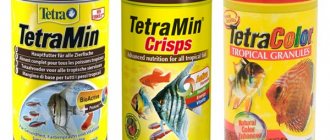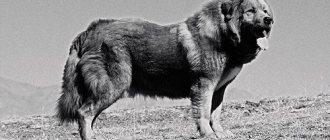4.3 / 5 ( 3 voices)
Good conditions for keeping a Tibetan mastiff can be created in a private or country house with a spacious plot and a strong fence. Don’t think that mastiffs are prone to running away from home, they just have highly developed protective instincts, and their spectacular appearance and powerful roar will scare anyone. Ancient chronicles indicate that to protect an entire village or monastery in ancient Tibet, only one Tibetan mastiff was considered sufficient. Therefore, in order to avoid problems with random passers-by, the fence should be made higher and stronger.
It is best to keep a Tibetan mastiff in a private house, not in an apartment.
Daily norm
Such a large dog needs high-quality nutrition, enriched with a sufficient amount of vitamins and minerals. When kept in an enclosure, Tibetan mastiffs need good food in order to withstand any weather conditions.
How many times a day to feed your dog depends on its age. Mastiff puppies are fed frequently, at least 4 times a day. After a year, dogs are switched to two meals a day.
The amount of food consumed depends on the size of the dog, but should be at least 3% of the total weight. For example, with a weight of 70 kg, the daily amount of food should be 2.1 kg. Considering two meals a day, we get about a kilogram portion of food.
It is worth noting that when feeding a dog with ready-made food, the portion may be smaller. Super premium food is already balanced and concentrated. The table on the packaging will help you calculate a single serving; it is present on any pack.
IMPORTANT!
You cannot overfeed your dog. Obesity may develop, which in turn can cause joint problems or heart disease.
Introduction
To raise a real breeding representative of the Tibetan Mastiff breed, you need to adhere to some rules. For example, prepare in advance for the puppy’s arrival. That is, provide him with the necessary conditions of detention. From the first moment your pet appears, you should begin to establish communication with it: pay enough attention, feed it properly, and so on.
Remember, giant breed puppies grow very quickly. Before you can blink your eye, the baby will turn into a huge dog. So that you and your pet can live in harmony, you need to familiarize yourself with the following rules and try to follow them:
- keeping a dog;
- dog care;
- raising and training a dog.
Let's consider each point in detail.
Dry food or natural food?
Breeders still have not come to a clear opinion on what is the best way to feed Tibetans. The only thing both sides agree on is that dogs cannot be fed a mixed diet . This may cause an excess of minerals or vitamins in the body, which will negatively affect the dog’s health.
Each option has its own advantages. When eating natural foods, you can be sure that what the dog eats, that it will not receive junk food or anything spoiled. In addition, feeding natural products is cheaper.
The advantages of ready-made feed are as follows:
- saving time on cooking
- a balanced complex of vitamins and minerals already included
- more convenient to feed
- Huge range for every breed and age
- confidence in the quality of the product
As a result, only its owner chooses what to feed the dog. The main thing is that in both cases the quality of the products does not suffer, otherwise the animal will suffer.
NOTE!
According to the veterinarian, it is better to feed the dog natural food. It has a more favorable effect on the functioning of the animal’s body, but it is necessary to add vitamins to the diet. If you still decide to feed dry food, then you need to choose a premium class, which definitely does not contain unnecessary additives. It will cost more, but the dog's health is worth it.
Feeding
Diet composition
The average calorie content of 100 grams of pet food is 450-470 kcal, but the nutritional value of the product is also important.
Take the Attention Test! Find 10 differences! (click right here!)
Find the answer Are you bothered by some problem or question? Enter “Breed” or “Name of the problem” into the form, press Enter and you will find out everything about the issue that interests you.
Mixtures are created from the following components:
- Proteins obtained by dehydration from meat - 25-32%;
- Cereals and legumes: wheat, rice, corn, barley - up to 21%;
- Fish (from 3 to 20-25%);
- Eggs - 3-5%;
- Plant components and extracts: vegetable fiber, fibers, extracts from pharmacopoeial plants;
- Animal fats - 8-10%;
- Minerals, vitamins and antioxidants;
- Preservatives - natural (class above Premium) or chemical.
Low-grade granules contain an extract from offal (up to 10-15%), and the concentration of meat or fish is not higher than 5%.
Choice
Mixed feeding is prohibited, so dry mixtures should serve as the main ingredient of the menu. As a result of the work of breeders, the mastiff has acquired a genetic predisposition to diseases of the cardiovascular system and digestive tract, and sick animals require a dietary diet.
A separate menu is selected for puppies, pregnant and lactating bitches, and aging individuals.
The granules should be dosed according to the manufacturer's instructions. Overfeeding is dangerous to health and can shorten life expectancy.
Pros and cons of natural food
Pros:
- Independent selection of products and their quality
- No preservatives, emulsifiers or other additives in food
- If you have an allergy, it’s easier to figure out the ingredient and replace it
- The presence of natural minerals in the diet - protein, fiber, carbohydrates and fats
- happy and contented animal
Minuses:
- it is necessary to maintain a strictly balanced diet so that all the necessary minerals are present
- need to add vitamin supplements
- takes a long time to prepare
- With natural feeding, it is difficult to travel with a dog, as it requires a place to prepare food
Upbringing
Representatives of this breed are independent and quite stubborn. Raising a puppy should be done from an early age. The main thing is persistence and patience. A willful animal may not immediately obey and begin to follow commands. You cannot give in to a dog; a disobedient adult animal can harm the owner and others.
In addition to stubbornness, the mastiff is characterized by boundless love and devotion to the owner and members of his family. Close communication with a loved one is important for a dog. This is a very sensitive animal, deeply experiencing rude and unfair treatment towards itself.
List of permitted and prohibited products
The following products are allowed for natural nutrition:
- lean meat (veal, beef, lamb)
- poultry (chicken, turkey, quail)
- ocean and sea fish (tilapia, tuna, pollock, white fish)
- milk products (low-fat yoghurts without additives, kefir, fermented baked milk, cottage cheese)
- cereals (rice, buckwheat). You can cook it in water, meat and fish broths. You can make porridge from several grains at once.
- offal (liver, lung, tongue, tripe, chicken offal). The portion is increased by one and a half to two times, since they have a lower energy value than meat.
- eggs. Chicken or quail. Give 1-2 times a week, raw or boiled.
- vegetables, fruits and herbs. It is a must to add to your dog's diet. Fresh, boiled or stewed, grated or pureed. But do not give too sweet and juicy fruits.
- bones. Only strong, non-tubular bones should be allowed to be chewed by the dog. They help remove plaque from teeth.
Prohibited products:
- boiled, tubular and fish bones
- fatty meat (pork, lamb)
- sweets and pasta
- sweets and confectionery
- smoked meats and sausages
- milk
- fresh, frozen meat
- by-products without heat treatment
- raw fish
- potatoes and tomatoes
- spicy and salty foods, marinades
- spoiled and sour products
- sweet and juicy fruits, citrus fruits
- cabbage, spinach, legumes - vegetables that cause fermentation in the intestines and flatulence
CAREFULLY!
Never feed your mastiff food from the master's table! This is not suitable food for your pet and will develop the bad habit of begging in your dog.
What vitamins are needed when feeding large breed dogs?
Vitamin complexes are an essential element of the diet of dogs fed boiled meat, offal and vegetables. But when feeding dry food, you may need to take additional vitamins. So that the supplement contains:
- Vitamin C is needed for the functioning of the immune system and ensures the full development of the muscular system, bones, joints, and teeth.
- Vitamin D - used for the formation of the skeleton, especially needed by puppies during the first year of their life.
- Calcium is absorbed along with vitamin D, used to form teeth, skeletal bones, and makes the coat beautiful and shiny.
For large dogs, vitamin complexes are suitable - Beaphar Top 10 Chondro Treat, Unitabs Immuno Complex and others.
Sample menu for a week for a mastiff
For each mastiff, the amount of daily food intake is calculated individually, depending on its weight. It must be at least 3% of the total weight of the animal.
The presented menu is designed for a dog weighing 70-80 kg for two meals a day. That is, the total volume of 2100 g is divided into two portions of 1050 g.
| Products | Days of the week | ||||||
| 1st day | 2nd day | 3rd day | 4th day | 5th day | 6th day | 7th day | |
| fish | — | 400 | — | — | — | 400 | — |
| raw meat, offal | 1000 | 600 | 1000 | 1000 | 1000 | 600 | 1000 |
| rice cereal | — | 400 | — | — | — | — | 400 |
| buckwheat | 400 | — | 400 | 400 | 400 | 400 | — |
| dairy products | 100 | 100 | 150 | 100 | 100 | 150 | 100 |
| eggs | 100 | — | — | — | 100 | — | — |
| vegetables and fruits | 400 | 400 | 350 | 400 | 400 | 350 | 400 |
| animal fat | 50 | 50 | 50 | 50 | 50 | 50 | 50 |
| salt | 50 | 50 | 50 | 50 | 50 | 50 | 50 |
Breeding
You can easily find breeders offering puppies online. It is recommended to purchase them only from trusted people. Specialized nurseries breed puppies. There are not so many of them:
- Moscow;
- St. Petersburg;
- Kiev
Kennels also provide the most reliable information about the puppy’s pedigree and health status. Throughout the entire period of the baby’s stay in the nursery, he is monitored by veterinarians. Therefore, it is recommended to take animals there. Before taking the puppy home, conduct an inspection and check the documentation.
A representative of the breed may be affected by a terrible eye disease - glaucoma.
Ready-made industrial feeds
The most convenient and fastest way to feed dogs is ready-made dry food.
Many breeders choose this method of feeding their pets due to convenience and time savings.
In order to choose high-quality dog food, you need to understand their huge range.
Advantages and disadvantages
Industrial feeds have their advantages and disadvantages, which must be taken into account when choosing food.
The benefits include:
- time saving
- wide range for all breeds and sizes
- convenience, you can take them with you on the road or give them as a reward
- long shelf life
- convenient dosage, the package indicates the dog’s daily feeding requirement
- the availability of medicinal and preventive feeds that are prescribed by veterinarians for gastrointestinal disorders in animals and various other ailments
NOTE!
Ready-made industrial feeds already contain all the necessary minerals and vitamins. Additionally, the dog does not need to be given anything, otherwise there will be an overabundance of substances, which can lead to various ailments of the animal.
The only downside is the high cost of food. Since high-quality feed is produced only from natural products, their cost is appropriate. It is also possible to get used to dry food and it will be difficult to accustom the dog to natural food.
Ready-made food has a huge range of food options. You can choose food for a specific breed, for pregnant, lactating dogs and newborn puppies, for active and sedentary animals, for small and large breeds, therapeutic and preventive and dietary food.
They are also available in several forms: dry granulated food, canned pates and pouches. The only difference between them is that with constant feeding of soft food, plaque will form on the dog’s teeth and you will have to brush the pet’s teeth yourself. Dry food prevents the formation of stone and plaque.
Feed classes
The quality of finished feed is designated by a certain category. The higher the quality of the food, the higher its class and the higher the content of natural products.
Type of classes:
- economy
- premium
- super premium
- elite
- holistic
Consumer grade food, that is, economy class, has a low cost, but its composition is appropriate. The low price appears due to low-quality, low-grade raw materials. These foods contain preservatives, dyes, flavorings and other chemical additives. All these components negatively affect the digestive system of dogs and the condition of the body as a whole.
Only premium, super premium and elite food meet all the requirements for high-quality animal nutrition. They have a completely balanced composition of proteins, fats, carbohydrates, vitamins and other essential substances.
Holistic food is intended for animals with a sensitive gastrointestinal tract.
IMPORTANT!
When feeding dry food, the dog should always have free access to water. The water must be changed twice a day.
Popular brands
As mentioned above, it is better to feed your dog with food of the highest category. These foods include the following manufacturers:
- Acana
- Flatazor
- Eukanuba
- 1st choice
- Brit Care
- DailyDog
- Bosch
- Trainer
- Josera
- Monge
- Gina
- Nutram
- Optima Nova
When choosing food, you must carefully study the information on the back of the package, the composition and expiration date.
We teach correctly
The Tibetan Mastiff is an independent and stubborn dog. Therefore, care alone will not be enough for her. From the first days a puppy appears in your home, you need to start raising and training it. Communication with your pet should be friendly, strict, without unnecessary emotions or aggression on your part.
Dogs of this breed are not particularly energetic and tend to make their own decisions. You will have to make every effort to make your pet respect and obey you. Therefore, training a Tibetan mastiff should begin with a general obedience course so that the animal can immediately adapt to new conditions.
Teaching a dog good behavior and manners includes teaching it a name, a toilet, a place, a feeding and walking schedule, and grooming procedures. Raising a pet must be combined with the basics of training, reinforcing each skill with the appropriate commands: “Come”, “Toilet”, “Place”, “Eat”, “Stand”, “Sit”, “Walk”.
Be sure to teach your puppy no commands. Use the "Fu" order if you want to stop the dog's action at the moment. The “No” order should stop any actions of your pet that are objectionable to you once and for all.
Remember, the Tibetan Mastiff, due to its stubborn nature, may not immediately begin to carry out your instructions. But if you can get him to learn a certain skill, then he will stay with the dog for a long time. However, do not forget to repeat the material covered from time to time, otherwise your pet may decide that the previous lessons no longer need to be completed.
Additionally, the dog will need to take a UGS (controlled city dog) course. Also, it would not be amiss for the Tibetan Mastiff to additionally take a course in training in the skills of protective guard service.
Tell us, how do you keep, feed, raise and train your dog?
How to feed a puppy?
The number of feedings a puppy depends on his age. In the first month of life, puppies eat only mother's milk in the amount they want. From the second month you need to add vegetables, meat and cereals to your diet.
The first complementary foods can be started at 3-4 weeks of age. Up to two and a half months, puppies are given special mixtures, mousses and pates. The food should be soft and mushy, a mixture with a temperature of 37-38 degrees.
From 3-3.5 months you can add minced chicken, boiled chicken, veal and turkey meat to puppies. You can also introduce fermented milk products: kefir, low-fat yogurt without additives and low-fat cream. From four months old, puppies can be introduced to solid food.
The number of feedings for puppies is as follows:
- up to 2 months - 6 times a day
- from 2 to 3 months - 5 times a day
- from 3 to 4 months - 4 times a day
- from 4 to 6 months - 3 times a day
- after 6 months - 2 times a day
The puppy's daily food intake is divided equally into the number of times depending on age. The diet should contain 60% meat product, 30% cereals and 10% vitamins, vegetables, and treats.
Grooming
The beautiful and thick coat of the Tibetan Mastiff requires careful daily care. From puppyhood, the pet is taught to comb with special brushes. The fur between the toes must be cut short to prevent dirt from accumulating on it and snow not sticking to it. If the dog does not participate in exhibitions, it is acceptable to trim the pants or remove the hair under the tail.
After bathing, special attention must be paid to completely drying the mastiff's thick undercoat. This is especially true if the dog lives on the street. By remaining wet for a long time, the animal runs the risk of catching a cold.
Content correctly
Keeping a Tibetan mastiff in apartment conditions is not the best option for such an animal. Even as a puppy, a mastiff will be able to knock over and break a lot of things. What can we say about an impressive adult dog? Therefore, it is best to arrange for a dog of this breed to live in a private house, where there is enough space to protect and fresh air.
The Tibetan Mastiff has a very dense coat that can withstand the characteristics of any natural conditions, be it cold or heat. Therefore, he can live outside all year round, even without a booth. Of course, there is no need to restrict the pet’s movements and its communication with the owner with an enclosure or fence. But organizing a canopy is a necessity that will save the dog from rain or snow.
You also need to install a high fence in advance, concrete its base. This is necessary so that the growing puppy, having a desire to get acquainted with the outside world, cannot crawl under the fence on his own. And an adult Tibetan Mastiff can jump over a low fence if it believes that its protective instinct may be useful on the other side.











